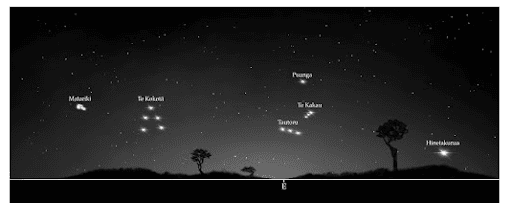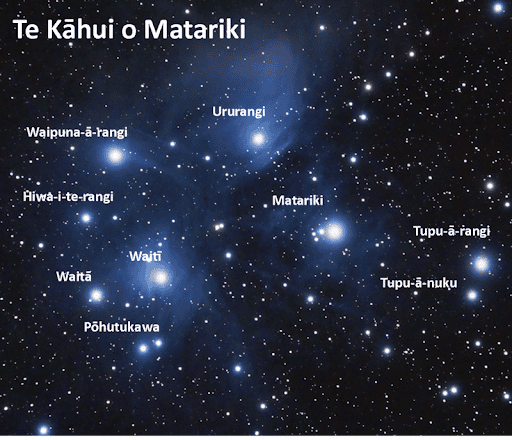Look up and explore Aotea’s stunning, starry dark winter sky with some tips from the Good Heavens team.
Stargazing Scorpius: The Scorpion or Maui’s fish hook
Scorpius, the Scorpion, is a prominent constellation in our evening sky in winter. It has a distinctive shape resembling a giant “J”. And in NZ, we see it as Maui’s fishhook! Scorpius is rich in mythology and stellar wonders. Here’s a guide to exploring Scorpius in the night sky:
Identification and Location
Scorpius is currently high in the NE in the evening sky. By 9:30pm it is above our head at the zenith. It can be easily identified by its curved body and extended tail, marked by bright stars such as Antares (Rehua in Maori).

Bright Stars
- Antares / Rehua: Antares is often referred to as the “Heart of the Scorpion,” Antares is a red supergiant which shines with a distinctive red hue, resembling the color of Mars. Rehua is the heavenly rangatira who gifted knowledge and wisdom to Tāne to bring back to earth.
- Shaula and Lesath: These stars mark the stinger of the scorpion and are notable for their brightness and proximity to each other. Shaula, comes from the Arabic الشولاء al-šawlā´ meaning ‘the raised [tail]’ and together Shaula and Lesath are sometimes called the “Cat’s Eyes”.
Deep-Sky Objects
If you have a pair of binoculars, look through Scorpius to see several sparkly deep-sky objects.
- Messier 4 (M4): A globular cluster located near Antares
- Ptolemy’s Cluster (M7) Ptolemy’s Cluster, a sparkly open star cluster located below the Scorpion’s tail. The patch of light is visible with your naked eyes, and with binoculars you’ll see many stars close together resembling glowing diamonds.
- The Butterfly Cluster (M6) The Butterfly Cluster, sits nearby M7 and is a sparkly open cluster whose shape resembles the wings of a butterfly
Mythology
In Greek mythology, Scorpius is associated with the story of Orion the Hunter. According to legend, Orion boasted of his hunting prowess, angering the Earth goddess Gaia. She sent a scorpion to challenge Orion, resulting in their eternal celestial chase across the night sky.
Observing Tips
- Dark Skies: To fully appreciate Scorpius and its celestial treasures, turn the lights off and head outside when the sky is clear.
- Binoculars or Telescope: Enhance your stargazing experience by using binoculars or a telescope to observe these stunning star clusters and nebulae.
Matariki: The star cluster bringing in the Maori New Year
Did you see Matariki during celebrations on the 28th June? If you want another look, or it’s your first time, Matariki will be visible in the predawn sky for the next few months, rising earlier every night. Note that Matariki is also known as the Pleiades star cluster. If you’re using a stargazing app, it’ll be called Pleiades there. Here’s a guide to observing this beautiful cluster:
Location and Visibility
- Position: The Matariki cluster is located in the constellation Taurus. It can be recognised by its compact arrangement of stars.
- Season: Matariki rises in the eastern sky in the early morning hours in winter, and gradually moves into the evening sky, where we can observe it from early November, till the end of April, throughout our long New Zealand summer.
- Predawn Viewing: Look to the NE a couple of hours before sunrise when the sky is still dark and the stars are prominent.

Observation Tips
- Dark Skies: On Aotea, you’re in luck as our sky is dark! But if you’re reading this from afar, you’ll need to find a location away from city / town lights to minimize light pollution. Also, remember to turn your torch off!
- Naked Eye or Binoculars:Matariki is bright enough to be seen with the naked eye, appearing as a small, fuzzy patch of stars. However binoculars really enhance your view by giving more clarity to the main stars and revealing many more stars within the cluster.
- Star Hopping: Use nearby bright stars like Aldebaran, the angry red eye of Taurus the bull to help locate the Pleiades / Matariki. Matariki is typically visible as a group of stars forming a tiny dipper-like shape.

Wishing everyone many special starry moments under Aotea’s Dark Sky Sanctuary sky!
Words from our Dark Sky Coordinator, Deb Kilgallon






















